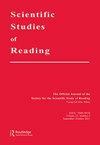儿童汉语正字法学习中的语义语音解码
IF 2.4
2区 教育学
Q1 EDUCATION & EDUCATIONAL RESEARCH
引用次数: 6
摘要
摘要在这项研究中,我们调查了儿童是否通过语义部首(我们称之为语义解码的机制)建立了从印刷到意义的联系,以及它与汉语复合字正字法学习中的语音解码的相互作用。92名四年级的孩子被教授了16个伪字符的发音和含义,然后接触他们在短篇小说中的书面形式。一半的字包含与所教意义相关的语义部首;另一半则毫无关联。一半的孩子学习了伪字符的规则发音;另一半学习不规则发音。在拼写和拼写选择方面,规则伪字符的拼写学习比不规则伪字符更好。然而,语义解码的效果并没有那么明确。研究结果表明,在汉语中,通过声旁解码是正字法学习的基础。然而,语义解码的效果可能更多地取决于部首的语言特征和学习环境。本文章由计算机程序翻译,如有差异,请以英文原文为准。
Semantic and Phonological Decoding in Children’s Orthographic Learning in Chinese
ABSTRACT In this study, we investigated if children build a print-to-meaning connection via the semantic radical – a mechanism we call semantic decoding – and its interaction with phonological decoding in orthographic learning of Chinese compound characters. Ninety-two Grade 4 children were taught the pronunciations and meanings of 16 pseudocharacters and were then exposed to their written forms in short stories. Half of the characters contained semantic radicals related to the taught meaning; the other half were unrelated. Half of the children learned the pseudocharacters’ regular pronunciations; the other half learned the irregular pronunciations. There was better orthographic learning of regular than irregular pseudocharacters across measures of spelling and orthographic choice. However, the effect of semantic decoding was not as unequivocal. The findings indicate that in Chinese, decoding via phonetic radicals underpins orthographic learning. Whereas, the effect of semantic decoding might depend more on the linguistic features of the radicals and the learning environments.
求助全文
通过发布文献求助,成功后即可免费获取论文全文。
去求助
来源期刊

Scientific Studies of Reading
Multiple-
CiteScore
7.20
自引率
2.70%
发文量
26
期刊介绍:
This journal publishes original empirical investigations dealing with all aspects of reading and its related areas, and, occasionally, scholarly reviews of the literature, papers focused on theory development, and discussions of social policy issues. Papers range from very basic studies to those whose main thrust is toward educational practice. The journal also includes work on "all aspects of reading and its related areas," a phrase that is sufficiently general to encompass issues related to word recognition, comprehension, writing, intervention, and assessment involving very young children and/or adults.
 求助内容:
求助内容: 应助结果提醒方式:
应助结果提醒方式:


